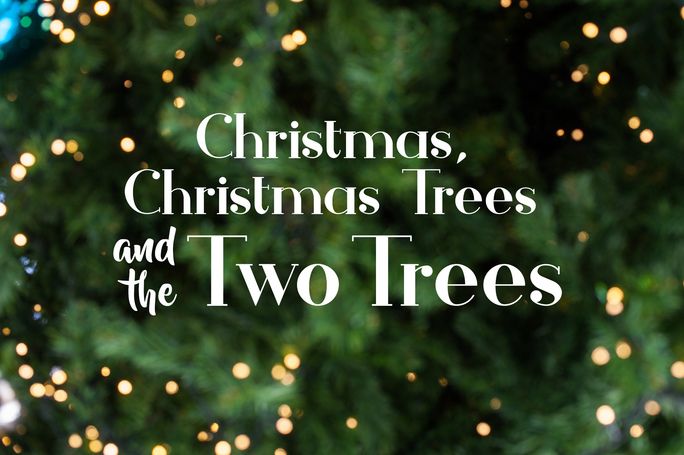Christmas, Christmas Trees and the Two Trees
The pagan origins of Christmas customs, such as decorated evergreen trees, are well documented. Are these customs harmless or harmful?

I grew up as a Coptic Christian, and I remember putting a tree up as a child and decorating it with lights (Coptics observe Christmas on Jan. 6). My family was not well-off, so our tree wasn’t surrounded with many presents. However, our family would prepare a special meal and enjoy the day together. I come from a very multicultural background and have been amazed to see even Muslims and Hindus celebrating this holiday and decorating trees.
Though some sources claim the Christmas tree tradition started in 16th-century Germany, the historical record is clear that the religious practice of decorating trees goes back thousands of years and long predates Jesus’ birth. Though many Christians know the pagan origins of the Christmas tree, they usually justify the practice by claiming that pagan practices can be redefined as Christian.
The Bible doesn’t directly mention Christmas trees (though you may be surprised that it gets pretty close!), but it does have a lot to say about two particular trees. Could the Christmas tree be symbolically related to one of these trees?
The two trees
When God created Adam and Eve, He placed them in the Garden of Eden. In the middle of the garden He planted two special trees. The Bible calls them the “tree of life” and the “tree of the knowledge of good and evil” (Genesis 2:9).
These two trees represent two different ways of life. These two ways can be summarized as God’s way vs. everything else. Let’s examine various ways they differ and discover where Christmas and Christmas trees fit in.
-
Obedience vs. Disobedience. God commanded Adam and Eve to avoid the tree of the knowledge of good and evil. Sadly, Adam and Eve chose to disobey God’s instruction. Later in history, God forbade adopting pagan customs to worship Him (Deuteronomy 12:4, 30). It’s no secret that Christmas and many of its customs are rooted in paganism.
Furthermore, God also gave instructions to avoid using decorated trees or carved wooden images to worship Him: “Do not learn the way of the Gentiles. … For the customs of the peoples are futile; for one cuts a tree from the forest, the work of the hands of the workman, with the ax. They decorate it with silver and gold; they fasten it with nails and hammers so that it will not topple” (Jeremiah 10:2-4, emphasis added throughout). Appropriating the Christmas tree to celebrate Jesus’ birth is in direct contradiction to this scripture—just as taking of the forbidden tree was.
-
Truth vs. Lie. Before Eve took of the forbidden fruit, Satan had lied to her about the consequences, saying: “You will not surely die” (Genesis 3:4). This directly contradicted God’s statement to the contrary (Genesis 2:17). Satan “is a liar and the father of it” (John 8:44).
When we look at Christmas, it is a holiday riddled with lies.
When we look at Christmas, it is a holiday riddled with lies. Many of the myths and traditions of Christmas contradict the Bible, such as:
- Jesus was not born on Dec. 25 (or Jan. 6). This time period was chosen because it coincided with the birthday of the sun (in many non-Christian religious traditions) due to its proximity to the winter solstice.
- The Bible does not say three wise men came to the manger when Christ was born. The Scriptures do mention an unknown number of wise men who visited the family at some point after Jesus’ birth when the family was in a house and Jesus was a young child (Matthew 2:1, 11).
- The myth of Santa Claus involves lying to children about a nonexistent person with godlike abilities.
To learn more, read “The Birth of Jesus: Myths and Misperceptions.”
-
Meaning vs. Pointlessness. Eating from the tree of the knowledge of good and evil left the whole creation “subjected to futility” (Romans 8:20). One way to interpret this is that mankind lost the hope and substance of having a connection with God and His truth. Since that time, humans have tried to devise their own religions or lived lives totally devoid of hope. Christmas is an example of a man-made attempt for substance, but when it’s really examined, nearly every part of Christmas is grounded in paganism, error or human tradition—and not God’s Word.
But God did give His people festivals that are loaded with meaning and answer life’s biggest questions. To learn more about those observances, read our free booklet From Holidays to Holy Days: God’s Plan for You.
- Patience vs. Now. Instead of completely avoiding the forbidden tree and patiently waiting for an opportunity to eat of the tree of life, Adam and Eve decided to pursue the option that seemed to offer immediate rewards. But that decision led to their being cut off from access to the tree of life (Genesis 3:22).
When Christmas is examined honestly, it’s clear that it springs from the tree of the knowledge of good and evil—not the tree of life. Life, Hope & Truth is dedicated to teaching about the tree of life—the way of life that is full of meaning, substance and truth. That’s why we encourage people to question Christmas and to discover the holy days found in the Bible. Unlike Christmas, they can truly change your life and help you better understand God and His plan for you.
Date Posted: December 22, 2017

 by Isaac Khalil
by Isaac Khalil

